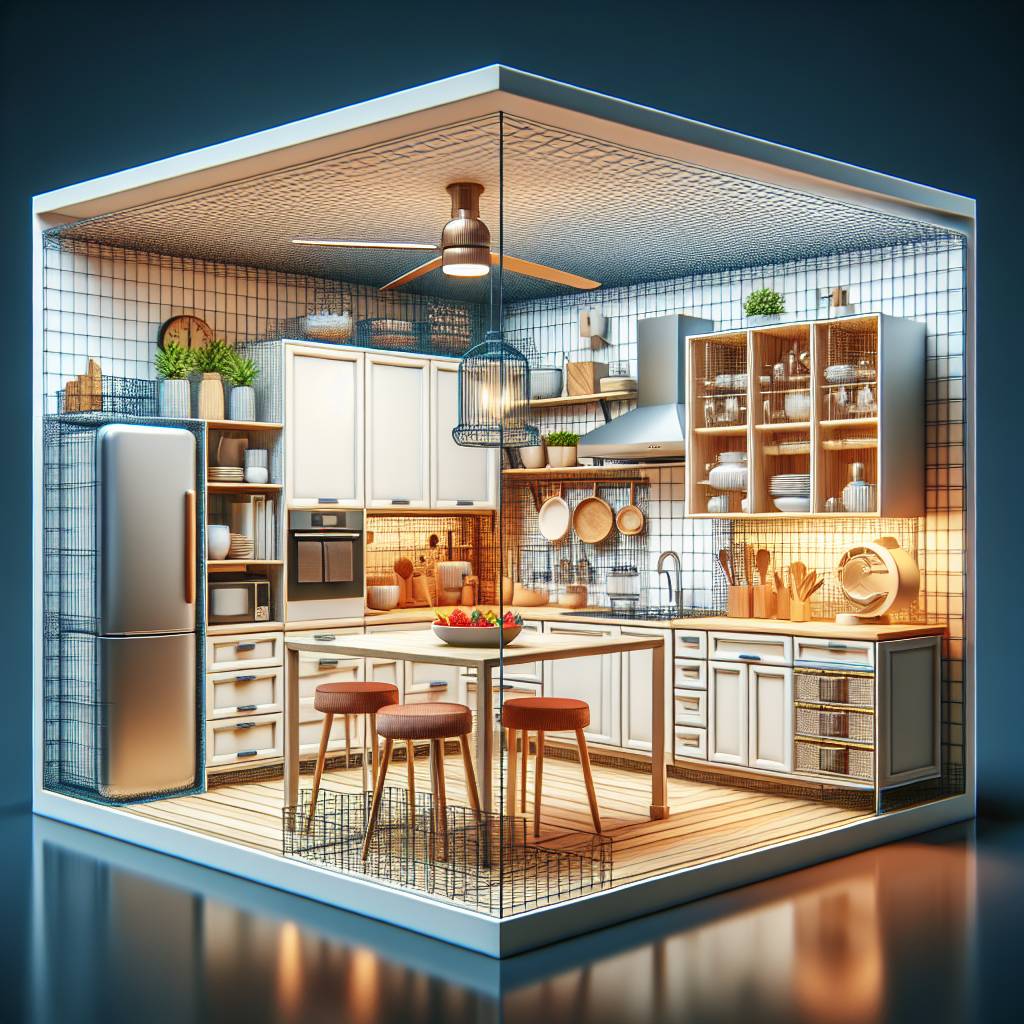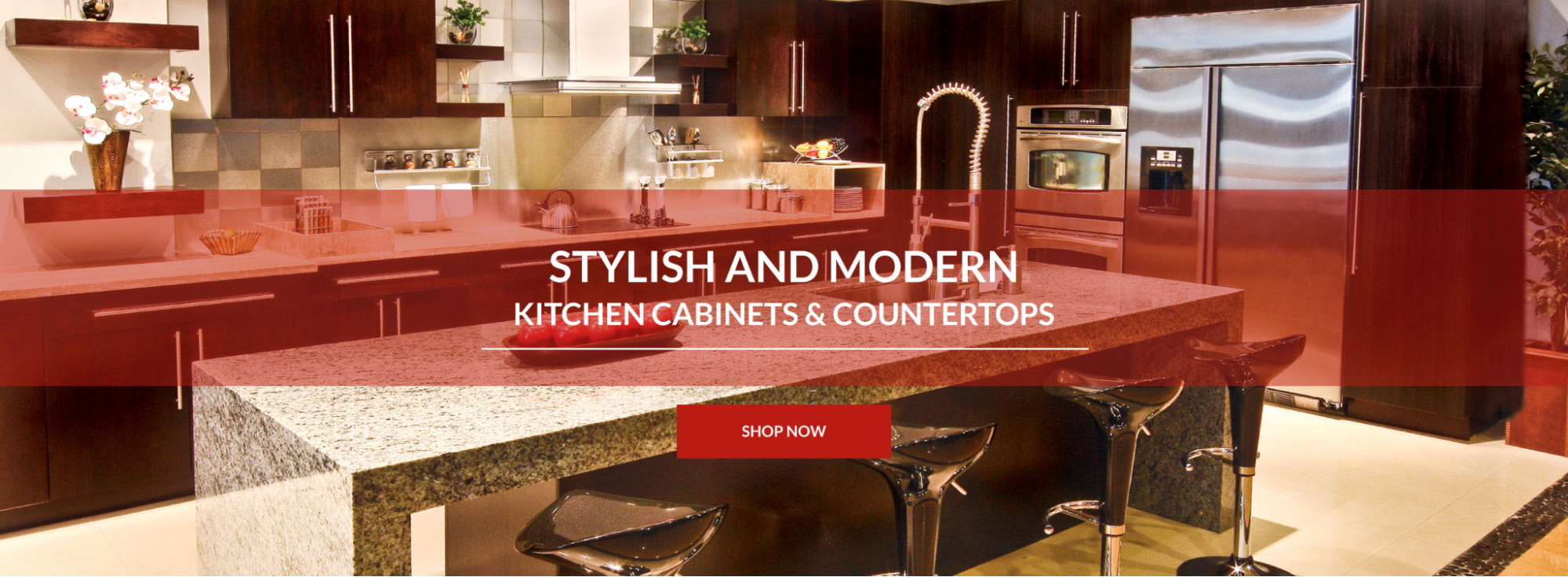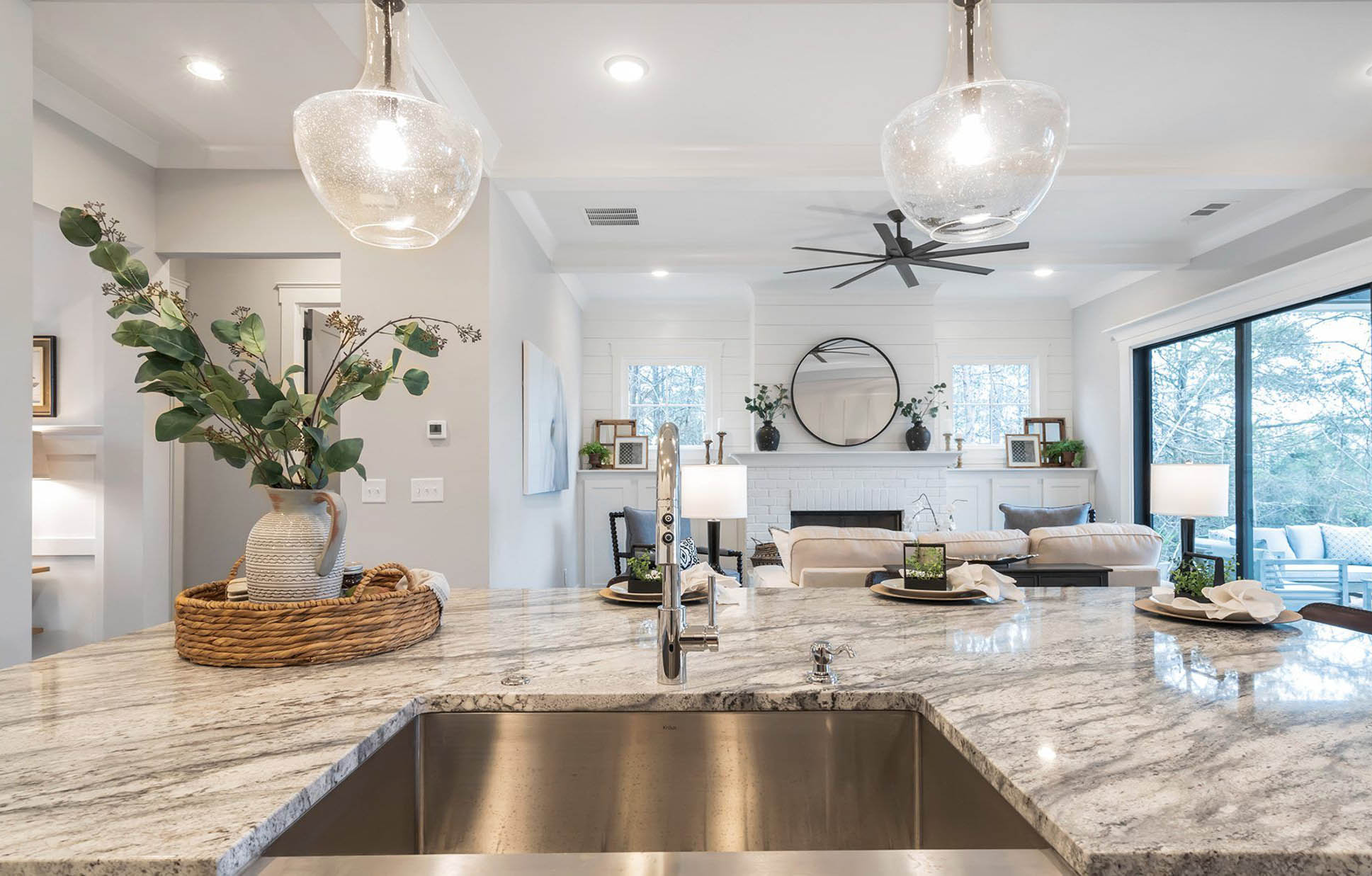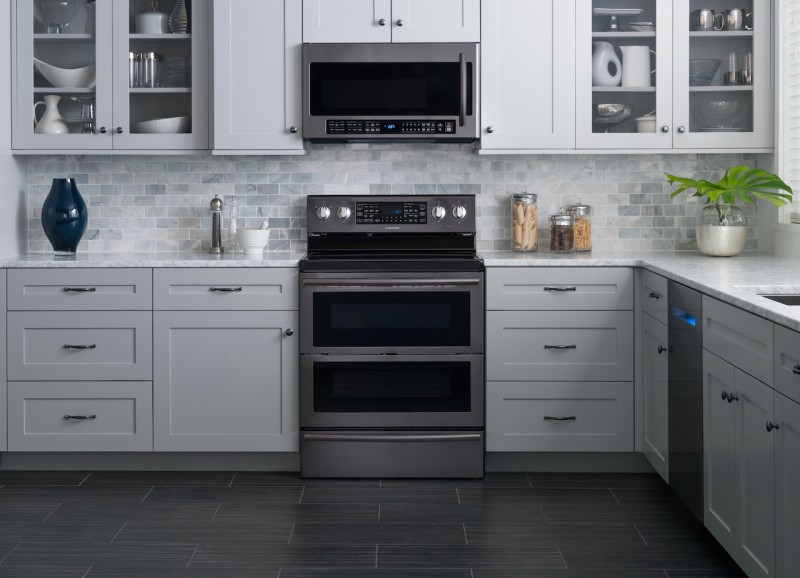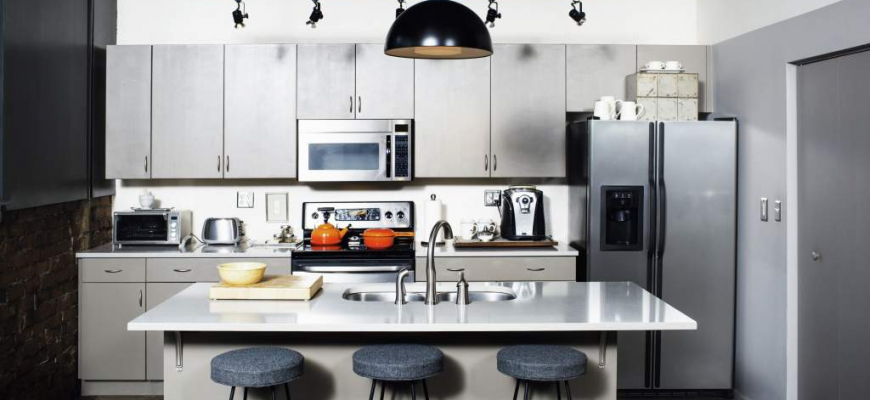Did you know that the average kitchen size in new homes has been shrinking over the past decade, now averaging around 150 square feet? But don’t let limited space cramp your style! With some strategic planning and clever design hacks, you can create a functional and stylish kitchen regardless of its size. In this post, we’ll explore practical tips for maximizing every inch of your compact kitchen while maintaining its aesthetic appeal. From savvy storage solutions to space-saving layout ideas, we’ve got you covered.
So if you’re ready to transform your small kitchen into a powerhouse of efficiency and charm, keep reading. You’ll discover how to make the most of limited space without compromising on style or functionality. Get ready to unlock the potential of your petite culinary haven with our expert advice and innovative design concepts.
Key Takeaways
- Maximize storage: Utilize vertical and overhead space, invest in multi-functional furniture, and consider pull-out storage solutions to make the most of limited kitchen space.
- Opt for light colors: Use light color palettes and maximize natural light to create an illusion of spaciousness in a small kitchen.
- Choose efficient appliances: Select compact and energy-efficient appliances to save space and enhance functionality in a limited kitchen area.
- Embrace spatial organization: Employ smart organization strategies such as cabinet dividers, drawer organizers, and wall-mounted racks to keep the kitchen clutter-free and functional.
- Utilize corners effectively: Explore innovative corner storage solutions to optimize every inch of the kitchen, such as rotating shelves or pull-out drawers.
- Consider multifunctional elements: Incorporate versatile kitchen islands or bars that can serve as extra workspace, storage, and dining areas without overwhelming the space.
Small Kitchen Design Layouts
Effective Planning
When designing a kitchen with limited space, assess your needs to determine what is essential. Prioritize functionality by considering the activities you often do in the kitchen. For example, if you love cooking elaborate meals, allocate more space for food preparation areas and storage for ingredients and utensils. Create a detailed plan that optimizes every inch of space available. This could involve utilizing vertical storage solutions such as wall-mounted shelves or hooks to free up countertop space.
Consider the kitchen layout that best suits your lifestyle. For instance, an L-shaped or galley kitchen layout can be ideal for small spaces as they maximize corner areas efficiently while providing ample room for movement. Think about how different elements will work together within the given area to ensure a smooth workflow.
Floorplan Optimization
Choose a layout that maximizes movement and storage without making the kitchen feel cramped. An open floorplan can create an illusion of spaciousness even in limited square footage kitchens by allowing natural light to flow freely throughout the space.
Opting for an open floorplan also gives you flexibility in arranging furniture and appliances while maintaining visual continuity from one area to another.Consider implementing the work triangle concept where the sink, stove, and refrigerator are positioned in proximity but not too close together – this promotes efficient workflow.
Space Illusions
To make a small kitchen appear larger than it actually is, utilize light colors such as white or pastel shades on walls and cabinets because they reflect more light compared to darker colors which absorb light creating shadows thereby making spaces feel smaller than they are.
Incorporating glass elements into your design scheme can add transparency and depth which contributes significantly towards creating an illusion of spaciousness within confined quarters – examples include glass cabinet doors or transparent countertops made from materials like quartz or tempered glass which allow light to pass through them thus giving off an airy vibe despite being physically compacted.
Another way to create an illusion of space is by strategically placing mirrors around your small kitchen – these reflective surfaces help bounce natural & artificial lighting around thus spreading brightness evenly across all corners resulting in visually expanded living spaces.
Maximizing Storage Solutions
When designing a kitchen with limited space, it’s crucial to maximize storage solutions. Utilizing the vertical wall space can significantly increase storage capacity. Installing tall cabinets allows for more items to be stored without taking up additional floor space. For example, hanging pots and pans on hooks or racks can free up cabinet space for other essentials.
Investing in multifunctional pieces is another effective strategy for optimizing storage in a small kitchen. Furniture with built-in storage solutions, such as benches with hidden compartments or coffee tables with drawers, serve dual purposes by providing seating or surface area while also offering valuable storage space. Choosing multipurpose kitchen tools and appliances reduces clutter and maximizes functionality within the limited kitchen area. For instance, a cutting board that doubles as a strainer eliminates the need for separate bulky items.
Incorporating hidden compartments into the design of a small kitchen enhances its organizational capabilities without sacrificing precious square footage. Hidden drawers integrated into cabinet designs provide discreet spaces for storing small items like spices or utensils, keeping them easily accessible yet out of sight when not in use. Toe-kick drawers are another innovative solution that utilizes otherwise unused space beneath lower cabinets for storing flat items such as baking sheets and trays. Furthermore, pull-out pantry shelves offer concealed storage options that blend seamlessly into the overall kitchen design while efficiently utilizing available room.
Color and Light for Space Enhancement
When designing a kitchen with limited space, the right color choices can make a significant difference. Opt for light colors such as soft whites, pale yellows, or light grays to create an airy and open ambiance. A monochromatic color scheme, where different shades of the same color are used, can visually expand the space by eliminating visual boundaries.
Strategically incorporate pops of color through small appliances, utensils, or decorative elements to add visual interest without overwhelming the space. For instance, in a predominantly white kitchen, adding vibrant teal bar stools or a colorful fruit bowl on the countertop can inject personality and warmth.
To enhance the sense of spaciousness in a compact kitchen, consider integrating reflective surfaces. Glossy finishes on cabinets and countertops can bounce light around the room, creating an illusion of depth and openness. Stainless steel appliances not only offer durability but also contribute to reflective surfaces that amplify natural and artificial light sources.
Furthermore, using glass or metallic backsplashes can add shine and depth to the kitchen while reflecting both natural and artificial light. These reflective elements help prevent the space from feeling closed-in by bouncing light throughout the area.
Maximizing natural light is crucial for enhancing a small kitchen’s atmosphere. Opt for sheer window treatments that allow ample sunlight to filter into your kitchen while maintaining privacy when needed. Positioning key work areas such as sinks or prep stations near windows allows them to benefit from abundant natural light during daytime hours.
Consider installing skylights or solar tubes if possible to bring even more daylight into your limited-space kitchen without sacrificing wall space for additional windows. These features not only maximize natural illumination but also create an open feel by drawing attention upward toward the ceiling.
Efficient Appliance Integration
When designing a kitchen with limited space, it’s crucial to focus on efficient appliance integration. This involves carefully selecting and incorporating appliances that are specifically designed for compact kitchens. One effective tip is to opt for slimline appliances, such as narrow-depth refrigerators and dishwashers. These sleek designs can save valuable space without compromising functionality.
Another important consideration is the prioritization of compact efficiency in kitchen gadgets and tools. By choosing smaller-scale equipment, you can maximize the use of limited space while ensuring that essential functionalities are not compromised. For instance, compact versions of appliances like microwaves and ovens can be selected based on their performance capabilities rather than their size.
Moreover, when working with a confined kitchen area, it’s beneficial to explore multifunctional worktops as part of the design strategy. Integrated cutting boards or built-in sinks within countertops offer practical solutions for optimizing workspace utilization. Fold-down or pull-out countertops contribute to creating additional workspace whenever necessary without overcrowding the kitchen area.
Spatial Organization Strategies
When designing a kitchen with limited space, it’s crucial to focus on spatial organization strategies to maximize functionality and create an aesthetically pleasing environment.
Decluttering Tips
Implementing a “one in, one out” rule can prevent clutter buildup in the kitchen. This means that for every new item brought into the kitchen, an old or unused item should be removed. Organizing cabinets with stackable containers and adjustable shelving units helps optimize vertical storage space, keeping the countertops clear and uncluttered. Designating specific areas for frequently used items such as utensils, cookware, and spices ensures easy access while maintaining order.
Zoning Techniques
Dividing the kitchen into zones based on functionality is essential for efficient use of limited space. By creating distinct areas for preparation, cooking, and cleaning, you can streamline your workflow and make the most of available space. Using different flooring materials or patterns to delineate each zone visually not only adds visual interest but also helps define separate functional areas within the kitchen.
Open Shelving Benefits
Installing open shelves in a small kitchen offers several benefits that contribute to both functionality and aesthetics. Open shelves provide an opportunity to display decorative items like glassware or ceramics while saving valuable cabinet space for storing essential items out of sight. Moreover, utilizing open shelving keeps frequently used items easily accessible without adding bulkiness associated with traditional upper cabinets. By incorporating open shelves instead of closed cabinets above countertops, you can create an airy feel in your small kitchen while making it appear more spacious.
Innovative Use of Kitchen Corners
When designing a kitchen with limited space, it’s crucial to maximize every inch, including the often-underutilized corners. Installing corner drawers or swing-out shelves can provide easy access to items that would otherwise be challenging to reach. These innovative storage solutions ensure that no space is wasted and that all your kitchen essentials are within arm’s reach.
Another clever way to make the most of corner spaces is by incorporating carousel-style inserts in corner cabinets. These rotating shelves allow for efficient organization and retrieval of items, eliminating the need to rummage through cluttered cabinets. By implementing these practical solutions, you can transform awkward corner areas into functional storage hubs, optimizing your kitchen layout without sacrificing valuable space elsewhere.
Strategic Nooks
In a small kitchen, creating strategic nooks can add both functionality and charm to the space. For instance, consider carving out cozy breakfast nooks with built-in seating and storage underneath. This not only maximizes seating capacity but also offers additional storage for cookware or pantry items—making it an ideal solution for compact kitchens where every inch counts.
Moreover, think outside the box. Transforming these spaces into custom wine racks or mini bars adds a touch of elegance while making efficient use of what might have been overlooked areas in traditional designs.
Integrating reading or work nooks within the kitchen area can serve dual purposes by providing a dedicated spot for relaxation or productivity without encroaching on valuable cooking and prep zones.
Adding Islands and Bars
Island Ideas
When designing a kitchen with limited space, consider incorporating a slimline island with integrated storage and seating. This type of island provides extra countertop space for food preparation, as well as storage for kitchen essentials. The integrated seating allows for casual dining without the need for additional chairs, making it an efficient use of space. For example, you can opt for an island with built-in shelves or drawers to keep cookware and utensils organized.
Another idea is to choose a mobile or expandable island to maximize flexibility in a limited kitchen area. A mobile island can be easily moved around the kitchen to create more space when needed, while an expandable one can be extended during meal prep and retracted afterward. These options are especially beneficial in smaller kitchens where adaptability is crucial.
Consider incorporating a multi-level island design that features both dining and prep areas. This innovative approach allows you to utilize the same piece of furniture for multiple purposes without sacrificing valuable space. For instance, the higher level can serve as a breakfast bar or dining area, while the lower level can be used exclusively for food preparation.
Breakfast Bars
To make the most out of limited kitchen space, install a fold-down breakfast bar attached to the wall. This practical solution provides extra counter space when needed and can be neatly folded back against the wall when not in use. It’s an ideal choice for compact kitchens where every inch counts.
Utilize a peninsula as an extension of your breakfast bar by adding stools on one side to create additional seating without taking up much floor area. Peninsulas are perfect for small kitchens since they provide versatility while maximizing available room.
When choosing bar stools for your breakfast bar, opt for ones that can be tucked under the counter when not in use. This feature helps maintain clear pathways within your kitchen when seating is not required, contributing to better flow and functionality in tight spaces.
Door and Flooring Solutions
When designing a kitchen with limited space, it’s essential to carefully consider the door and flooring solutions. Opting for sliding doors can be an excellent way to save swinging door clearance, especially in cramped kitchens. For instance, sliding barn doors not only add a touch of rustic charm but also eliminate the need for extra space required by traditional swinging doors.
Another clever use of sliding pocket doors between rooms can help maximize space utilization in small kitchens. These pocket doors slide into the wall, freeing up valuable floor area that would otherwise be taken up by the swing radius of a standard hinged door. Incorporating sliding glass doors leading to outdoor areas can seamlessly merge indoor and outdoor spaces while saving precious room inside.
In terms of flooring choices, selecting large-format tiles or planks is an effective way to visually expand the floor space in a compact kitchen. The larger size creates fewer grout lines, giving the illusion of a more expansive area. Moreover, choosing light-colored flooring options such as pale wood or light-toned tiles enhances the airy feel within limited kitchen spaces.
Seamless flooring transitions between the kitchen and adjacent areas are also crucial when dealing with confined spaces. By using consistent flooring materials throughout adjoining rooms, you create a sense of continuity that makes each area feel connected without any visual interruptions caused by abrupt changes in flooring type or color.
Aesthetic and Functional Accessories
When designing a kitchen with limited space, it’s crucial to focus on aesthetic and functional accessories. By incorporating timeless accessories, you can create a visually appealing space that maximizes functionality. Classic hardware designs like brushed nickel or brass finishes add an elegant touch to the kitchen while standing the test of time. These finishes also contribute to a cohesive look when paired with other elements in the kitchen.
Timeless pendant lighting fixtures with clean lines not only provide adequate illumination but also serve as stylish accents. They don’t take up valuable counter or floor space, making them ideal for compact kitchens. Opting for traditional yet functional accessories like wooden cutting boards adds warmth and practicality to the kitchen environment. These items can be displayed on walls or leaned against backsplashes when not in use, serving as both decor and tools.
Art and decor play a vital role in enhancing the visual appeal of a small kitchen without compromising functionality. When working with minimal cabinetry, strategically displaying artwork on walls becomes essential for adding personality to the space without overwhelming it. This approach allows you to maintain an open feel while infusing art into your design scheme.
Incorporating decorative accents that complement the kitchen’s color scheme ties everything together harmoniously. For instance, if your color palette consists of soothing neutrals, consider introducing decorative elements such as ceramic jars or woven baskets in similar tones to maintain cohesiveness.
Furthermore, integrating live plants or herb gardens serves multiple purposes – they act as natural decor elements while also providing fresh herbs for cooking within arm’s reach. Utilizing vertical wall space by installing floating shelves can accommodate these green additions without encroaching on precious countertop real estate.
Remodeling Considerations for Small Kitchens
Budget-Friendly Remodels
Budget-friendly remodels are essential. Start by focusing on the most critical elements, such as storage solutions and maximizing functionality. Look for cost-effective ways to create more storage, like adding shelves or installing cabinets that reach the ceiling. Utilize every inch of available space efficiently.
Consider repurposing existing items before purchasing new ones. For example, instead of investing in a brand-new kitchen island, consider using a movable cart or repurposing an old table to serve as extra counter space. These small changes can make a big difference without breaking the bank.
Another budget-friendly option is to focus on simple yet impactful upgrades, such as replacing cabinet hardware or updating light fixtures. These minor changes can significantly enhance the overall look and feel of your kitchen without requiring a substantial financial investment.
- Pros:
- Cost-effective solutions
- Maximizes functionality
- Allows for creativity within budget constraints
- Cons:
- Limited scope for major structural changes
- May require more effort in finding affordable alternatives
Cohesive Look Creation
Creating a cohesive look in a small kitchen involves careful planning and attention to detail. Start by choosing a consistent color scheme that complements the overall aesthetic you want to achieve. Use light colors like white or pastels to visually expand the space and create an open, airy feel.
Opt for streamlined designs and minimalistic patterns when selecting materials for countertops, backsplashes, and flooring. This helps maintain visual continuity throughout the kitchen while preventing it from feeling cluttered or overwhelming due to too many competing elements.
Incorporate multi-functional furniture pieces that serve dual purposes while contributing to the unified design theme. For instance, choose dining chairs that also provide hidden storage compartments or opt for foldable tables that can be expanded when needed but tucked away when not in use.
Closing Thoughts
You’ve now got a solid grasp on how to transform your small kitchen into a functional and stylish space. By focusing on smart layouts, maximizing storage, playing with color and light, integrating efficient appliances, and employing spatial organization strategies, you can make the most of your limited kitchen space. Don’t forget about innovative solutions for corners, adding islands or bars, selecting the right doors and flooring, and incorporating both aesthetic and functional accessories to truly elevate your kitchen.
Now it’s time to roll up your sleeves and start implementing these tips. Get creative, think outside the box, and remember that even the smallest changes can make a big difference in a compact kitchen. With the right approach, you can turn your kitchen into a place where efficiency meets elegance. Your small space has huge potential – go ahead and unlock it!
Frequently Asked Questions
How can I maximize storage in a small kitchen?
Maximize vertical space with tall cabinets and shelves. Utilize the insides of cabinet doors for hanging storage. Consider pull-out drawers and organizers for efficient use of space.
What color and lighting choices work best for enhancing a small kitchen’s space?
Opt for light, neutral colors to create an open and airy feel. Maximize natural light with strategically placed windows or skylights. Incorporate layered lighting with under-cabinet lights to brighten up the workspace.
What are some efficient appliance integration tips for a small kitchen?
Choose compact, multi-functional appliances that save counter space. Consider built-in or concealed appliances to maintain a streamlined look. Opt for slim, energy-efficient models that fit seamlessly into your layout.
How can I effectively organize the limited space in my small kitchen?
Utilize wall-mounted racks and hooks for pots, pans, and utensils. Group similar items together in designated zones to streamline workflow. Invest in stackable containers to keep pantry items organized.
What are some innovative ways to utilize corners in a small kitchen design?
Install swing-out corner units or carousel-style shelves to access deep corners easily. Consider diagonal drawers or custom corner cabinets tailored to maximize every inch of available space.
